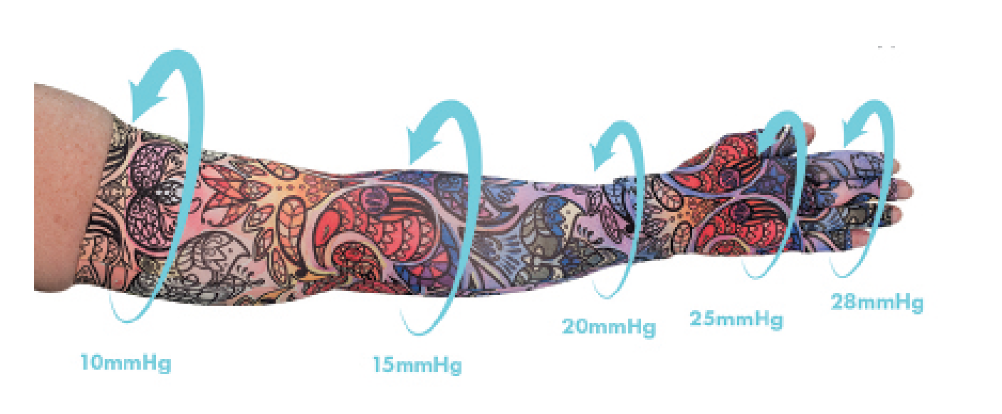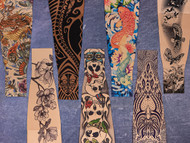How does medical graduated compression work for lymphedema management?
Medical graduated compression garments are an integral part of lymphedema therapy. Since the lymphatic system does not have a built-in pump like the circulatory system, the purpose of a graduated compression garment is to aid in moving lymphatic fluid. This is accomplished by a graduated decrease in pressure to effectively push the lymph fluid from an area of high pressure to an area of lower pressure. Properly fit compression garments will reduce lymph fluid stagnation which can cause the onset and advancement of lymphedema.
So, what does it really mean when an arm sleeve says it delivers Class 1 (20-30 mmHg) compression? Even seasoned professionals may be stumped by this question because the science behind compression garments is seldom explained. Each medical graduated compression garment is assigned a compression class which determines how much pressure that garment delivers. In the United States, Class 1 is defined as 20-30mmHg, and Class 2 is defined as 30-40mmHg. The 20-30mmHg or 30-40mmHg indicate the amount of pressure that the garment will provide at the most distal point from the body. For example, a 20-30 mmHg arm sleeve has pressure starting between 20 and 30 mmHg at the wrist, and that pressure should decrease gradually at each measuring point.

It is important to note that the practice of compression varies from the theory of compression simply because there isn’t a single approach to determining the best range of compression based on the severity of edema. For instance, in the United States, 20-30mmHg is standard compression for prevention and minimal edema and 30-40mmHg is standard for moderate to severe edema. In the UK on the other hand, 15-20mmHg is standard for prevention and minimal edema and 20-30mmHg is standard for moderate to severe edema, with 30-40mmHg rarely used. These varied recommendations are based on practice experience, as no trustworthy studies exist to determine the best range of compression based on the stage of edema. It is also important to note that more compression than necessary can be equally as harmful as insufficient compression. It is important to work with your medical team to determine the right compression class for you.
Compression
The main goal in choosing a compression garment is finding a garment that will provide the necessary pressure at all points. Therapists will look at lymphedema severity, presence of localized swelling, level of self-care, accessibility, and other medical factors when determining whether to recommend a custom-fit garment or a ready-made (off-the-shelf) garment. They will also consider these factors in determining whether you need an arm sleeve, gauntlet, and/or glove.
When fitting for compression garments we hear remarks about how tight they feel, and while it has been a long time since we have put on compression for the first time, it is always an adjustment when putting on a fresh, new sleeve. Garment tightness is often considered an uncomfortable side effect of compression sleeves and some individuals are more sensitive to compression than others. That’s why it is the philosophy of our medical board that it is best to start with the lowest compression needed to manage the severity of the individual’s edema and only move to a higher pressure garment if necessary.
Compliance
How likely are you to wear a garment that is uncomfortable, hot, or itchy? We bet it is probably not very likely. So another major factor in considering which compression garment works best to manage lymphedema is whether the garment will actually be worn. Sure, there might be a garment that is hot, thick, and completely immobilizes the limb that is super effective but if you cannot put it on, and can only wear it for a few minutes at a time before feeling physical or emotional discomfort, how much good can that garment be doing sitting in a drawer? We believe firmly that no compression garment can be the best if it isn’t being worn, so the best compression garment for you is the one that you wear.
In summation, there isn’t a one-size-fits-all solution to fit each individual’s needs. If you’re new to compression or a compression pro, it is important to know that you have options. Now that you know what to look for and ask for in a compression garment, you can work with your therapist to find your perfect garment.
